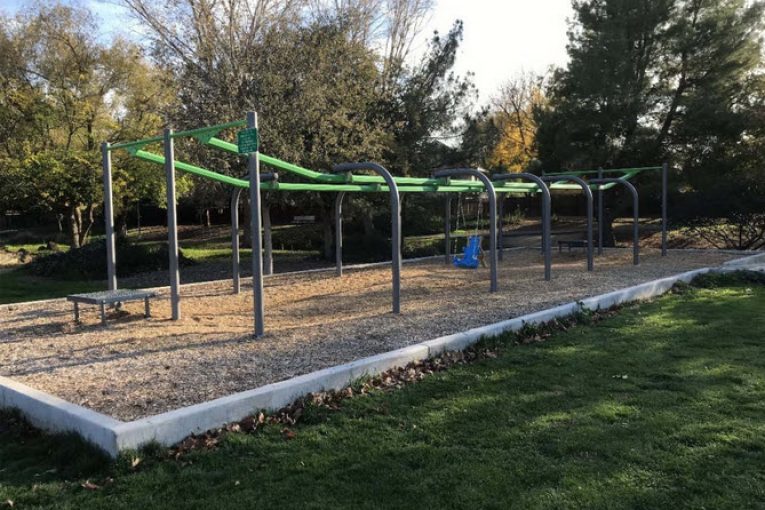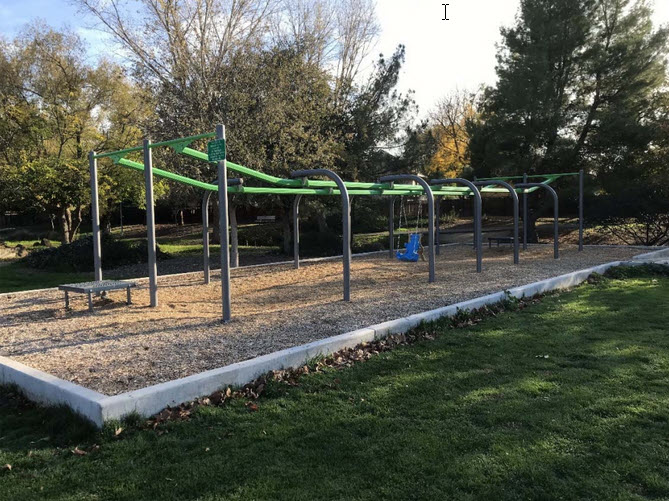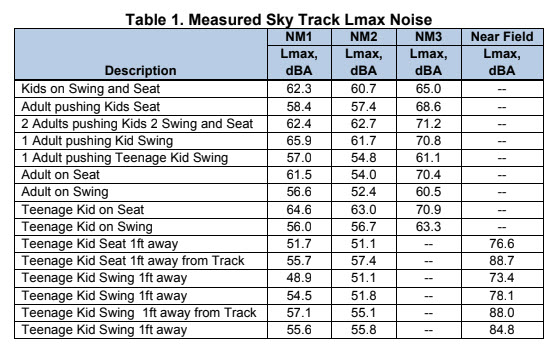

by: Janet and Joe Krovoza
Regarding Arroyo Park’s Sky Track, here’s the latest reveal: data omitted from a March 1, 2022 noise report shows that for the three years of the Sky Track’s use, the apparatus has been in constant violation of the city’s noise standard of 55/50 dBA (day/night). This same data shows that alternative locations in Arroyo Park will violate the noise ordinance – day and night.
Last December, the city’s Acoustic Group, Inc. (AGI) consultants collected, but then buried, the relevant maximum (Lmax) noise data from the new March 1 report. With the Lmax data conveniently missing from its 40 pages, the AGI report continued the city’s bizarre use of average noise (measured in Leq) and the equally necessary policy assertion that “Maximum Noise  Level (dBA)” explicitly stated in the ordinance really meant “average.” This theoretically allowed for a potential new Sky Track location in Arroyo Park to squeak by within .5 dBA of compliance.
Level (dBA)” explicitly stated in the ordinance really meant “average.” This theoretically allowed for a potential new Sky Track location in Arroyo Park to squeak by within .5 dBA of compliance.
Confronted again on its use of Leq and their it-says-maximum-but-means-average trick, staff refuses to own their mistaken decision and they are now asking the Rec and Park Commission to clean up their mess by endorsing a reinterpretation of the noise ordinance that will increase every noise maximum in the city by 20 dBA – huge increases on a logarithmic scale, with citywide implications. This 20 dBA increase would apply to residential, commercial/industrial, and high traffic corridor noise – all in the name of placing an amusement park caliber aparatus close to homes. We lay this out further below.
Reinterpreting the Noise Ordinance to Justify the Sky Track
In their determination to justify their no-notice, unilateral 2018 decision to place the Sky Track in Arroyo Park, city staff are now taking a new approach in their quest to reinvent the noise ordinance so that it can accommodate their past decision. While an attempt to rush through noise ordinance changes at the City Council level over Memorial Day weekend 2021 was withdrawn, the new effort to change the ordinance relies on a never-before posited interpretation underway before the Rec and Park Commission. The commission, of course, has zero charge to create or interpret noise policy; they are required, however, to follow it.
You may recall the tremendous blowback from staff’s 2021 attempt to change the ordinance to use one-hour noise averaging citywide, and other significant changes such as the city exempting itself from the ordinance altogether. The staff report was rather ignominiously pulled from the agenda by city manager Mike Webb at the start of the June 1, 2021 council meeting. Mr. Webb apologized “for the confusion in terms of process and lack of clarity around the item.” Webb went on to say, “We will work to improve upon that moving forward,” adding that, “I think engaging with the planning commission for advisory input would also be appropriate.”
And yet instead of going through the inconvenient process of a policy change, on Tuesday, June 21, staff are summoning representatives of the two sound engineering firms, AGI and Bollard Acoustical Consultants (BAC) that have produced reports analyzing the noise to a special meeting to posit their interpretations of city policy.
The city-paid consultants are expected to endorse the staff position that “maximum” means average, and that there’s another provision never before cited by the city in this context that allows for a plus-20 dBA addition to the existing 55/50 dBA residential noise maximum. If this sounds to you like the city is saying: “max means average; and what says maximum is really 20 dBA below the real max,” you are correct. And note that the hired consultants are experts in measuring noise, not interpreting municipal code and certainly not a code they had nothing to do with writing. Yet city staff are eager to have them tell the Rec and Park Commission what our city’s ordinance really means, and, in fact, to tell us that it means what staff tried, but failed, to get approved by the City Council last year.
This is fallout from the Rec and Park Commission’s March, April and May meetings, when staff had hoped to secure a recommendation for a new Sky Track location within Arroyo Park, but were again caught using average Leq readings, not maximum Lmax measurements. The staff’s problem was present in a new form: if forced to reveal the Lmax readings, they’d need to somehow change the ordinance to make the Lmax data comply with their new Sky Track location. And that’s exactly what they are attempting to do.
What the Noise Ordinance Says
Let’s get grounded in the law. Davis Municipal Code 24.02.020 (a) “No person shall produce, suffer or allow to be produced on any public or private property, sounds at a level in excess of those enumerated in Table 1…What’s above is the exact table from the noise ordinance, highlights added. We would wager that 10 out of 10 people would define “maximum noise level” limit as something along the lines of “the loudest something can be.” In fact, this has been city staff’s interpretation as well up until they realized they weren’t in compliance with their own ordinance. That’s what led to last year’s staff report released on the eve of Memorial Day weekend for the following Tuesday’s meeting, asking the city council to replace “maximum” in the code with “average” to better meet the needs of the “urbanized area” Davis has apparently become (Watsonville, Madera and Napa all rank higher on the “urban area” scale, btw).

New Interpretation to Make the Sky Track Comply
Well, now we have recreation and parks director Dale Sumersille and her division asking the Recreation and Park Commission to approve a major revision to noise policy because two consultants paid to collect data have told them that, despite what it says, the policy means average, not maximum. In her May 16 staff report, Ms. Sumersille reveals that “Both the BAC and AGI studies have determined that the City Standard is a Leq,”
There are so many reasons this makes no sense. Of course, the motivation is self-serving and cynical. Also, the plain meaning of a statute is always the first, and almost always the last, stop when interpreting a law. But wait, there’s more. The expression “Leq” – the metric that gives the average noise level and doesn’t capture the maximums – appears nowhere within the ordinance – nor does the word “average,” for that matter. Further, any noise average standard must specify the duration of the averaging, and yet there’s nothing even hinting about duration in the noise ordinance – and why would there be? The ordinance explicitly states “maximum.”
It is particularly galling that the city is clinging to this absurd interpretation to describe the noise made by the Sky Track, which by its nature is highly variable: relatively steady (swing scraping along track) and impulse (swing hitting end of track) noise that is completely dependent on the weight/velocity of an infinite range of users. (Just imagine how this invented average method would apply to pickleball! Or a party next door that’s only loud for 20 minutes each hour?)
The Data That’s Relevant
Just late last week we learned that in addition to the irrelevant Leq numbers, AGI did record the relevant maximums in its measurements for the March 1 report. However, they didn’t disclose these numbers that would doom a Sky Track for Arroyo Park. This wasn’t transparent at best and was unethical at worst. Or maybe there just wasn’t room in the 40-page report?
Now the Lmax numbers are out and they are as high as 63 dBA at our property line. The newly-revealed Lmax data also shows that if the Sky Track were moved to a new location in Arroyo Park, maximum noise will exceed the 50/55 dBA maximum limits day and night, with neighbors to the south experiencing noise at least as loud as 56.9 and neighbors to the north, 56.5.
Below are the newly revealed Lmax numbers. In “Table 1” NM 1 and NM2 are the homes to the south and all of the use examples violate the city’s nighttime standard and the vast majority violate the daytime standard as well. “Table 2” shows that alternative locations B (likely the city’s preferred new spot) and C violate the standard day and night. Locations A (out of compliance and rejected by the school district that doesn’t want this distraction near Patwin Elementary) and D (way out of compliance) are not being considered as alternative locations.


Siting the zip track anywhere in Arroyo Park will violate the city’s maximum residential noise limits of 55/50 dBA. Thus, it’s clear why staff wishes the true limits were averages and not maximums.
Davis Will Become an Outlier
To answer the argument that using average, or Leq, noise is standard practice and that Davis is somehow an outlier by using maximum, a study released in 2016 found that of the nearly 500 cities surveyed, only about 40 use Leq, showing that Davis is actually in very good company when it asserts that maximum sound limits are what matter. As Robert Lawson, a retired UC Davis/UCDMC health and safety professional with extensive training on noise issues, reported in the Davisite last year, San Diego appears to be the only UC campus community that specifies Leq in its noise ordinance. Several use a sliding scale for averaged sound levels but with specific mention or provisions to account for impulsive noise, the type generated by the Sky Track. Even if Davis properly amended its ordinance to use averages, it would need to account for impact noises.
If you think a new 75 dBA maximum residential noise limit sounds high (vacuum cleaner!), you are correct. Commercial/industrial noise would now go to 80 dBA (busy street traffic) and still be fine. Davis would be joining the ranks of the most industry-oriented cities, betraying the opening sentence of its noise ordinance: “It is declared to be the policy of the city, in the exercise of its police power, to prohibit unnecessary, excessive and annoying sound levels from all sources.”
Raising every noise maximum in the city by 20 dBA to retroactively justify a single piece of park equipment isn’t just unseemly, it will make Davis a true outlier and a laughing stock.
Time to be Honest
Staff installed the Sky Track without following the city’s own community noticing guidelines, and without even sharing their decision with the Rec and Park Commission until well after the purchase was underway. Since realizing there was a legitimate noise issue as soon as it went in, staff tried and tried to use average Leq data to establish compliance and then hid the relevant Lmax data once it was collected. Realizing they had a problem, last year staff asked the city council to change the ordinance so their Leq data could bring the Sky Track into compliance, but the council declined to do so. Now staff hopes to use their paid consultants and the Rec and Park Commissioners to reinterpret the policy. This is our city? The staff cost of these three-plus years of subterfuge must be enormous. All to cover a mistake.
City manager Mike Webb and the city council need to step up. Staff must acknowledge the impact of the Sky Track using the city’s existing noise regulations and the appropriate Lmax data. To do otherwise would be to subvert the will of all citizens, contradict the plain meaning of its ordinance, and impose fallacious standards capriciously and cynically.





